How SLEEPING BEAUTY Set The Stage For The Anti-Princess Movie
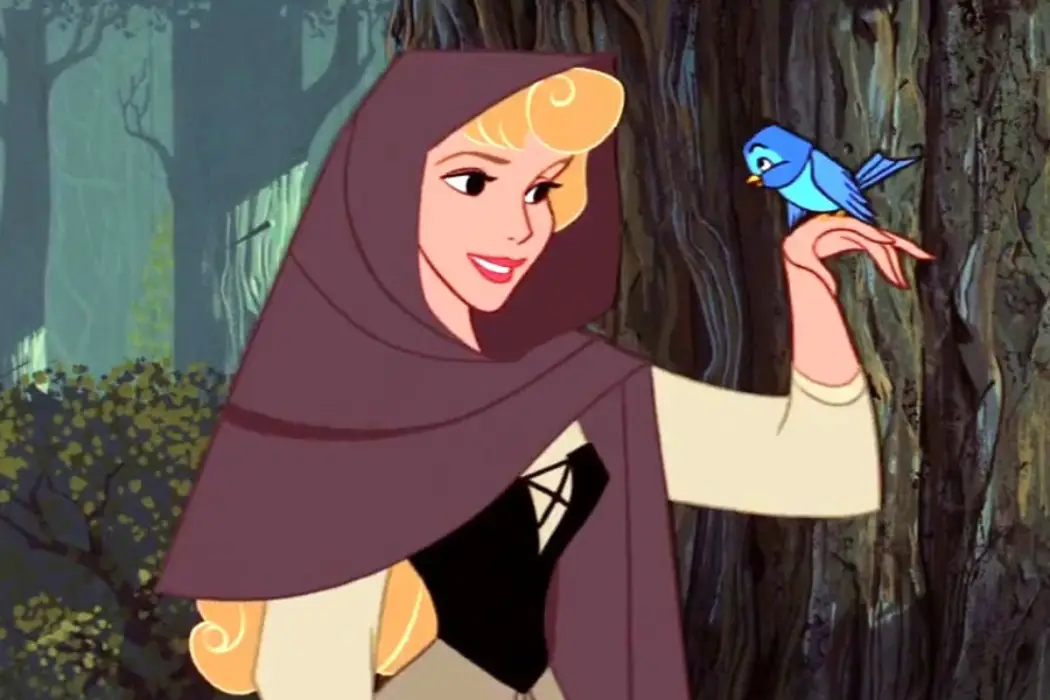
Payton McCarty-Simas is a freelance writer and artist based in…
Princess movies were staunchly banned in my house growing up. My mother, a hot headed feminist and all-around badass, hated the sexist, disempowering formula of princess films so intensely that she turned off our DVD copy of Mulan right after Mulan helped defeat the huns every time I watched it (she’s not even a princess at this point); I only learned she married Li Shang years later, and boy, was I upset. Unless the film had some element of the revisionist anti-fairytale to it, i.e., Shrek (2001), Enchanted (2007), and Tangled (2010), where the princess stands up for herself and only winkingly engages in the sexist and patronizing tropes of the genre proper, I probably didn’t watch it until I was in my twenties. In light of that, seeing Sleeping Beauty (1959) at the Museum of the Moving Image in Super Technirama 70mm as a part of their fantastic monthly “World of Animation” series was a shocking and wonderful experience.
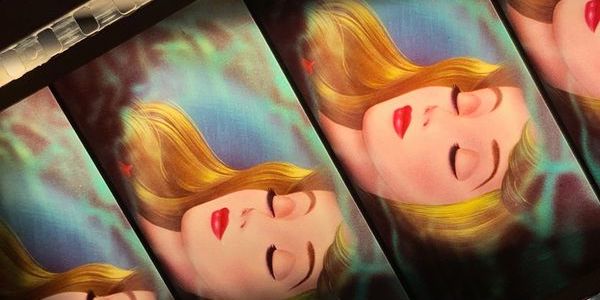
In my head, Aurora from Sleeping Beauty was the “pink” princess. When you go shopping for Halloween costumes hoping to be a pirate or a wizard for your entire childhood, the princess section of the Spirit Halloween can be divided more comprehensibly by dress color than by any discernible differences between Disney princesses’ personalities – mainly because there aren’t any–– a fact that became emblematic of the entire princess film genre for me. In a similar vein, my understanding of Sleeping Beauty as a film, drawn by osmosis from the cultural landscape, was that it was just another Disney classic where princes fight dragons and princesses get married off at the end. Neither of my vague notions about the film proved true. Aurora quite literally isn’t the “pink” princess at all, and the film certainly isn’t just another Cinderella story: It’s a complex and unfixed work borne from a deeply troubled production at a moment of profound transition for Disney’s Animation Studios. Is it sexist? Incredibly. But it’s more complicated than that. From subtly proto-psychedelic sequences to dialogue and narrative elements that seem to presage the postmodern princess films of the 21st century, it’s no wonder that Sleeping Beauty serves as the touchstone for anti-fairytales like Enchanted.
Once Upon A Time…
The films that most centrally define our understanding of classic Disney princess movies are: Snow White and the Seven Dwarfs (1937) (a.k.a the red-and-blue one), Cinderella (1950) (the blue one), Sleeping Beauty (1959) (the “pink” one) and even Beauty and the Beast (1991) (the yellow one). Though Beauty and the Beast was part of the later, more postmodern “Disney Renaissance” of the 1990s, it was originally conceived as a Disney film in the 1930s, putting it in conversation with the others on this list. Structurally and thematically, they’re almost all virtually interchangeable: a young woman, disliked by people more powerful than herself, faces adversity and misunderstanding in her quest for love, and gets married to her Prince Charming. At first glance, Sleeping Beauty is no different. But the film was mired in serious production problems for years and the animation team found themselves wrestling with such fundamental questions as whether doing another princess movie was even a worthy endeavor. Unsurprisingly, the finished product refuses simple characterizations.
As filmmaker, author, and animation historian John Canemaker explained during his introduction for MOMI’s screening of Sleeping Beauty, the film was in production for a full ten years, conceived in 1949 during a period of intense strife for the studio. Naturally, such a tortured production schedule led to an identity crisis for the film’s creative team and the direction the film should take. The highly successful period between 1937 and 1942, retroactively known as Disney’s “Golden Age,” produced classics such as Fantasia (1940), Dumbo (1941), and Snow White. While many of these films were actually financially disastrous at the time, the unprecedented success of Snow White meant that the outlook for the studio was positive overall. During WWII however, already facing narrow margins coming into the 1940s, Disney Animation faced tightened budgets, smaller teams, smaller markets and a period of near-bankruptcy. Desperate for a postwar comeback, the studio produced Cinderella in 1950, the first critical and financial feature film hit the studio had seen since Snow White over a decade before. Thus, riding on its success, Sleeping Beauty’s production began. As the ’50s wore on, however, Walt Disney‘s ambitions became split between live action filmmaking, the creation of Disneyland in California, and the animation studio, pulling resources away from Sleeping Beauty. The production went on for so long in fact, the first director, Wilfred Jackson, died of a heart attack before animation even began. The film was to become the most expensive animated film ever made up to that point.
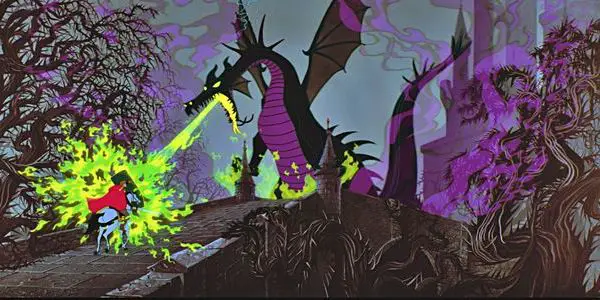
Disney was frank about the troubles plaguing Sleeping Beauty even beyond the logistical quagmire of production. The central problem the film faced was one of originality. “We were fighting to break away from what we had done in the past.” Disney said according to Canemaker. “Sleeping Beauty was tough, because it had many of the elements we had already used in Snow White and Cinderella. We had a lot of problems.” Indeed, many of the early plot ideas for the film were scenes and concepts that were cut from the older two films – and it shows clearly in the plot. The paradox at the heart of Sleeping Beauty, simultaneously positioned as a quasi-cash-in from Cinderella and as a standalone film worthy of a highly creative animation team, is palpable in the finished film. As an unforeseen consequence of the challenges it faced, the desperate, drawn-out nature of the scripting and production process actually lends the film an unintentional air of semi-camp pastiche that, ironically, makes Sleeping Beauty incredibly unique in the classic princess canon – on top of being a visually breathtaking feat of animation.
“I Just Love Happy Endings!”
Fairytales are one of the most basic forms of storytelling; thus, all fairytales rely on a fundamentally understood formula for their underlying structure. Sleeping Beauty, based on a 17th-century French fairytale of the same name (though the first version of the story itself can be found in the 14th-century chivalric romance, Perceforest), is no different. In brief, Sleeping Beauty (the film) is about a young princess, Aurora (Mary Costa) cursed by an evil fairy, Maleficent (Eleanor Audley), vexed at not having been invited to her first birthday party. Maleficent curses her to prick her finger on a spinning wheel and die on her sixteenth birthday. Another fairy present, Merryweather (Barbara Luddy), uses her birthday gift to alter the curse so that, rather than die, Aurora will sleep until true love’s first kiss awakens her. Merryweather and her sisters, Flora (Verna Felton) and Fauna (Barbara Jo Allen), hide the girl in the woods for sixteen years where, just a day before she pricks her finger and falls into a deep sleep, she fatefully meets her betrothed husband-to-be, Prince Phillip (Bill Shirley) and they fall in love. Her prince must fight a dragon and kiss her under pain of letting the entire population of the royal court sleep forever. He does and they live happily ever after. However, perhaps due to the stop-and-start nature of the scripting process and production itself, Sleeping Beauty‘s conventional narrative is treated with less credulity than in prior Disney films.
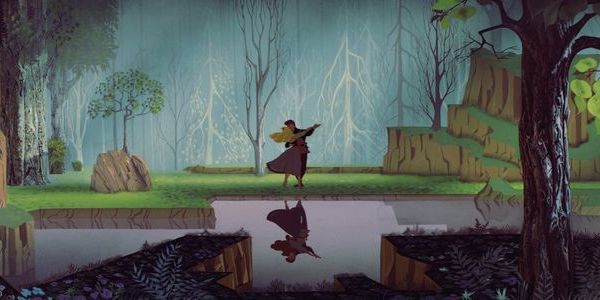
Though the film begins with the same classic storybook opener from Snow White and Cinderella that introduces many of the narrative elements, here many of those same conventions are directly pointed out with a shrug or a playfully meta line of dialogue rather than glossed over. For example, early in the story when the boy prince Phillip is introduced to his betrothed “bride-to-be,” the infant Aurora asleep in her cradle, the narration formally and floridly describes how “fondly had… two monarchs dreamed their kingdoms to unite… [therefore] Phillip, Hubert’s son and heir, to Stephen’s child would be betrothed… and so looked upon his future bride.” The scene itself is conventional, showing the court stunningly rendered by the artist John Hench who drew inspirations directly from Medieval art and architecture. And yet, when the boy looks into the cradle of his betrothed seven years his junior – something typical of the historical period that would likely be passed over in older films – his brows furrow in a face that seems to ask, “really?” This metatextual distancing from the plot is further highlighted by the fact that the moment takes place in a medium closeup which situates the small boy at eye level with the viewer, showing only the oblivious adults’ hands and torsos Peanuts-style: in so doing, the film lets the audience in on a joke about the nature of monarchy unbeknownst to the adult royal characters themselves.
These attempts to freshen up the story continue in Phillip’s rebellious relationship with his father, particularly when he states his intentions to marry a peasant girl instead of a princess: “Now father, you’re living in the past!” he exclaims when his father protests his intention to dissolve an important political alliance in favor of marrying a stranger, “This is the 14th century! Things are different nowadays…” Like his incredulity at his bride’s relative youth, the lightly mocking modernization of a Medieval story stands in stark relief from the other princess films of the period.
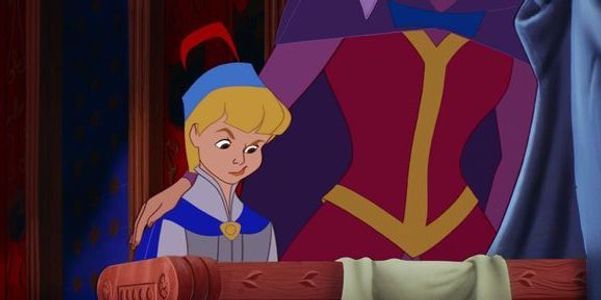
The narrative itself continues to resist the traditional machinations of a fairytale plot all the way through the film. When the Prince and Princess finally come together for their first dance at the end of the film after Maleficent’s spell has been lifted, the King Hubert (Bill Thompson), still under the impression that Phillip insists on marrying a peasant girl, is flummoxed as to what happened. “What does this mean boy?” he splutters as the two dance past, “but – but… I don’t understand!” He looks to Aurora’s father for answers and finds him passively nodding along to the couple’s love theme. After receiving no clarity as to how the exact scenario he’d hoped for for two decades arose, he shrugs enormously and dances along as well. Fate is a ubiquitous plot contrivance of the genre, but having its convenience pointed out so directly, (with unconventional plot holes i.e. how did the three good fairies survive without magic for sixteen years if they never learned to cook or clean or sew for themselves as we see in the sequence on Aurora’s sixteenth birthday?) adds a sly freshness to the otherwise conventional plot.
Similarly, while the narrative is largely coherent, leaps in logic presumably cemented in the typical viewer’s mind by previous exposure to earlier Disney films and fairytales are pointed out directly. While questions of how Prince Phillip and Aurora fall in love under such unlikely circumstances are explained with the traditionally simple explanation of “we’ve met before – once upon a dream” which parallels neatly with the song “A Dream Is A Wish Your Heart Makes” from Cinderella, they’re also self-consciously laid out for the viewer by Maleficent (herself the most obviously post-modern Disney villain of the period) in a speech to Prince Phillip as he sits chained in her dungeon.
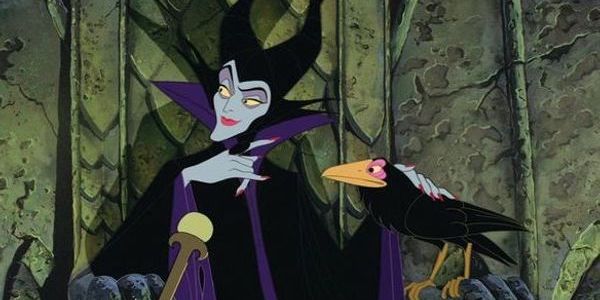
“Come now Prince Phillip, why so melancholy? A wondrous future lies before you, you the destined hero of a charming fairytale come true!” She croons, a mocking smile on her face. As she uses her crystal ball to show him Aurora in her tower, her grin broadens and she arches an eyebrow before continuing in a faux-surprised tone, “But see the gracious whim of fate! Why, tis the selfsame peasant maid who won the heart of our noble Prince just yesterday!… on his noble steed, a valiant figure, straight and tall, to wake his love with love’s first kiss, to prove that true love conquers all.” The direct reference to the convenience of fate as a fairytale plot device is shocking and the last lines are delivered with such open villainous derision and deliciously devious self-awareness that Maleficent seems to break the diegesis of the narrative. Of course, true love still does conquer all as it necessarily must, but Maleficent’s mocking, dismissive cognizance of the tropes at play, in tandem with the viewer’s own understanding of the genre, once more winkingly brings the text much closer to the viewer than previous entries into the genre.
“But See the Gracious Whim of Fate!”
Beyond overt references to plot conventions, the film’s offhandedly postmodernist tendency extends to its narrative structure. Maleficent herself is a central example. Unlike the female villains of Snow White and Cinderella, Maleficent isn’t motivated by envy. In both previous films, these “evil” women were characterized by a sexist jealousy over the princess’s looks that motivated the entirety of the films’ plots (in essence: “who’s the fairest of them all – and why isn’t it me?”). The evil stepmother in Cinderella is a slightly more unfixed form of evil than the queen in Snow White, but her motivations can still be understood as self-interested because torturing Cinderella provides her with slave labor. In Sleeping Beauty, however, Maleficent is just evil. Every character loathes her for unclear reasons, some even referring to her as a “creature” or an “it.” Her name literally means “evil doer,” and her henchmen are anthropomorphic demons straight out of a Bosch painting. She is also, fascinatingly, seemingly above the hierarchy of the kingdom in which she dwells, with the queen herself referring to her as “your excellency.” While a feud with the monarchy is implied, she has no backstory or real motivation in the diegesis of the film; she sets the plot in motion with a curse simply because she wasn’t invited to a party she doesn’t even seem that disappointed to be missing. Her one liners are so dry (of her henchmen: “Oh, they’re hopeless. A disgrace to the forces of evil”), it’s no wonder Susan Sarandon‘s evil queen in Enchanted is an intentionally obvious, wickedly gleeful impersonation of her.
Flora, Fauna, and Merryweather, though clearly examples of the fairy godmother trope exemplified by Cinderella, are also, unexpectedly, the primary agents of the plot. Whereas in Cinderella the fairy godmother appears as a deus ex machina, helps Cinderella along in her journey, and vanishes again, these three fairies (and Maleficent their villainous counterpoint) hatch every plan in the film from hiding Aurora to putting the princess to sleep to rescuing Prince Phillip. They even kill Maleficent themselves, enchanting Prince Phillip’s sword and stabbing her just as Maleficent is about to drive our “destined hero” off a cliff. Meanwhile, both kings are depicted as comic relief with no power, even over their children. For a genre decried for its chivalric sexism, the fact that the female fairies – or the emissaries of the fairytale’s most important component, fate – control the entire story once again undermines the tropes at play.
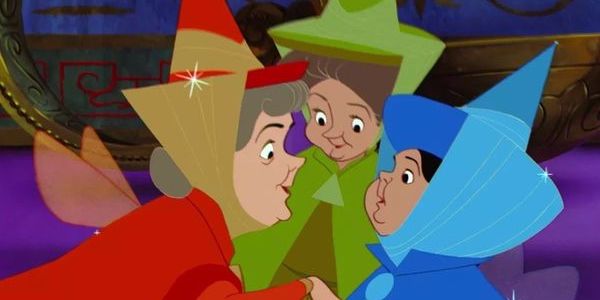
Aurora and Phillip also highlight the fairytale conventions at play by exemplifying them almost too well rather than directly subverting them. While princesses and their princes in general aren’t particularly fleshed out characters, Aurora and Phillip are strikingly undefined. The animal friends that come with the territory of being a misunderstood princess are unexplained here, unlike in Cinderella where she spends her afternoons saving mice from cats and rat traps, gaining their friendship in exchange. Aurora has no interests or hobbies (even of the cleaning-for-the-seven-men-you-live-with or making-clothes-for-mice variety). Her personality, defined by beauty and a lovely singing voice, are literally gifts bestowed on her by her fairy guardians on the day of her birth, underlying the constructed nature of the princess narrative. In the same way, Prince Phillip is introduced during a song Aurora sings about her dream prince (“Once Upon a Dream,” one of the only songs in the film, another interesting difference between this film and others in the genre) wherein her animal friends construct a simulacrum of him using Phillip’s actual clothing, rendering him just as artificial a product of fantasy as she is.
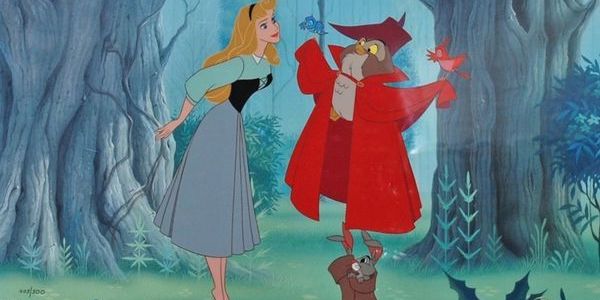
Aurora’s lack of definition is most self-consciously pointed out through the question of (here it is again) the color of her princess dress. When her personal trio of fairy godmothers pull a bippity-boppity-boo and make her a magical dress for her reintroduction to her father’s court, they just can’t settle on a color, troubling the straightforward, fateful transformation narrative laid out by Cinderella a decade before. Merryweather (the fairy in blue) and Fauna (the fairy in red) have a magical paintball fight over the dress, changing it from pink to blue and back again with such force that at one point the dress becomes a mess of tie dye splatters. This gag is foregrounded to such an extent that it concludes the movie and adds another twist to the classic fairytale moment, the happy couple’s concluding romantic dance. As they dance (and King Hubert looks around in askance for a plot summary) Merryweather weeps tears of joy and exclaims, “I just love happy endings!” in another obviously meta-referential allusion to the conventions at hand. Fauna agrees until she notices that the dress is still blue. “Pink!” She mutters, “blue!” Merryweather responds, and the two fairies’ battle continues, causing the dress to flash from blue to pink and back again as the couple dances off into the sunset sky, the storybook closes, and the chorus sings their final notes. In Cinderella, her mouse friends make her a pink dress for the ball that gets destroyed by her evil stepsisters, only to be replaced with a silvery blue one by her fairy godmother. The psychedelic antics of Aurora’s dress then can be interpreted as a joking reference to this plotline. The question remains, however, why, then, has Aurora been sold as the “pink” princess in Halloween stores across the country when she spends the majority of the time in blue? Presumably, because Cinderella’s costume is blue already (even though her dress was arguably white).
Conclusion:
More than Cinderella before it, Sleeping Beauty is a fascinating and complicated film that can be viewed as a meta-commentary on the genre it helped to cement as a fundamental part of American film culture. Is it exactly as sexist as my mother condemned it to be? Yes and no. Aurora is indeed a helpless, one-dimensional feminine stereotype – but Phillip is a hapless, one-dimensional masculine stereotype, too. He doesn’t even slay the dragon himself, instead relying on the powers of the good fairies to defeat Maleficent, their evil counterpart. The film, both due to the troubled production itself and the artists’ desire to reimagine earlier princess tales, seems in many ways to presage the winking modern adaptations of these tales full of airheaded pretty boy princes and delicious camp villains. No self-rescuing princesses here, obviously, it’s indeed arguably the worst offender of the literal passivity of the princess genre – yet, that very fact unintentionally adds to a reading of the film as an incidental commentary on the conventions of the genre as a whole.
The cracks in the princess formula, as Walt Disney himself knew, were already beginning to show by the end of the 1950s, an era of cultural domesticity and censorship-mandated happily ever afters. Sleeping Beauty‘s light teasing of a genre whose possibilities seemed to have run their course, itself a product of a troubled production, was a step towards the deconstruction of the genre that, ironically, ended up revitalizing it in the 1990s with tales like The Little Mermaid (1989), Beauty and the Beast (1991), Pocahontas (1995), and Mulan (1998) in addition to even more recent revisionist stories like The Princess and the Frog (2009), Frozen (2010), and Brave (2012).
What do you think? Let us know in the comments!
Sleeping Beauty is now available to stream on Disney+.
Does content like this matter to you?
Become a Member and support film journalism. Unlock access to all of Film Inquiry`s great articles. Join a community of like-minded readers who are passionate about cinema - get access to our private members Network, give back to independent filmmakers, and more.
Payton McCarty-Simas is a freelance writer and artist based in New York City. They grew up in Massachusetts devouring Stephen King novels, Edgar Allan Poe stories, and Scooby Doo on VHS. She's currently earning her MA in film, media, and sexuality at Columbia University, focusing their research on horror film, science fiction, psychedelia, and the occult in particular. They live with their partner and their cat, Shirley Jackson.













